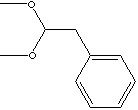| Ether is any of a number of organic compounds characterized by an oxygen atom
joined with single bonds by two carbon atoms that are part of hydrocarbon
groups. The general formula is R-O-R', where R and R' are alkyl or aromatic
groups. Ethers are formed by the condensation of two alcohols by heating with
sulfuric acid; the reaction is one of dehydration. Ethers can be prepared from
alkyl halide reacted with metallic alkoxide (called Williamson synthesis).
Ethers are similar to alcohols but are generally less dense, less soluble in
water, and have lower boiling points. They are relatively unreactive, which
makes them valuable solvents. But ethers will be
cleaved at high temperatures by concentrated hydrogen halides. Ethers have relatively low boiling point
compare to alkanes as they don't form hydrogen bonds each other. Ethers are more
lipophilic than esters [R-C(=O)-O-R']or amides [RCO-NH2]. Ethers are widely used as solvents for various organic reactions because they
are relatively the least reactive among common organic compounds except alkanes
and fluorocarbons. The common reaction of ethers is cleavage of the C–O bond by
strong acids either in linear chain or cyclic structure. Ethers in which oxygen
is bonded to primary and secondary alkyl groups can form peroxide compounds in
the presence of gaseous oxygen due to two unpaired electrons in oxygen. Ethers can act as
Lewis bases in chemical reactions. Commonly, ethers are
named simply in listing the alkyl groups in alphabetical order or alkane order
such as ethyl methyl ether or methyl ethyl ether, which is methoxyethane in
IUPAC nomenclature ( the formula of "alkoxyalkane" ). When ether is a
parts of complex molecule or aromatic derivatives, it is described as an alkoxy
substituent such as methoxybenzene ( trivial name is anisole). The methoxy
prefix indicates the function methyl group joined by single bonds to an oxygen atom,
with the general formula -O-CH3. Cyclic ethers
have ring structure where the oxygen has become part of the ring. The term of
epoxide indicate three membered cyclic ether (also called oxirane) in which an
oxygen atom is joined to each of two carbon atoms that are already bonded to
each other; four
membered cyclic ether is called oxetane; five membered cyclic ether, furan (or
oxolane); six membered cyclic ether, pyran (also called oxane) respectively.
Their unhindered oxygen atom carries two unshared pairs of electrons - a
structure which favors the formation of coordination complexes and the solvation
of cations. Cyclic ethers are used as important solvents, as chemical
intermediate and as monomer for ring-opening polymerization. Crown Ether is a macrocyclic polyether whose structure contains
hydrogen, carbon and oxygen atoms. Each oxygen atoms are confined between two
carbon atoms and exhibits a conformation with a hole (accordingly called
"crown"). Anisole is one of the simplest aromatic compound to
which ether group is linked. But
it is different with aromatic compounds like furan where the oxygen is a part of
the ring. Anisole, C6H5OCH3
(methyl phenyl ether), is a clear liquid that is soluble in ether and
alcohol; insoluble in water; boiling point 155 C. Anisole and its derivatives
are used as solvents and in perfumery. Anisole can be obtained from anise seed.
Anisic acid, p-methoxybenzoic acid, is a part of cresol class antiseptic
compounds. It
is also used as an insect repellent and ovicide.
Anisole, anisic acid, and their derivatives are also widely used in
chemical reaction as intermediates to obtain target materials such as dyes,
pharmaceuticals, perfumes, photoinitiators and agrochemicals. Acetals are geminal-diether derivatives of aldehyde
by combination of an aldehyde molecule with two alcohol
molecules and elimination of water. The formula is RCH(OR')2, where R and R' are aliphatic or aromatic
radicals. If the formula is RCR'(OR")2, it is called The
"acetal" also refer toindependent structural units in
certain biological and commercial
polymers. Lower acetals are colorless volatile liquid used as a solvent and in
cosmetics but higher acetals are solid. It is soluble in ether and alcohol
but slightly soluble in water. It is unstable in acid
but stable in base.
Acetal polymers
(polyacetals) are tough and hard plastics used as substitutes for metals.
Acetal homopolymers
are produced by the polymerization of
formaldehyde. Acetal copolymers
are produced are by the polymerization of
formaldehyde with trioxane. In nature the most stable glucose exists as a cyclic hemiacetal and
maltose is an acetal made from two glucose units.
Acetal
formation is reversible (hydrolyzed back to their starting
components by treatment with aqueous acid). In order to achieve effective acetal formation an acid catalyst must be used
and the water
produced with the acetal must be removed. p-Toluene
sulfonic acid is often used as a catalyst in the formation of acetal which water must be removed from the reaction mixture to
escape reversible reaction. Water is removed azeotropically
by distilation. (Toluene is the solvent). A way to remove
water is to use an orthoester as a source of alcohol;
water produced along with the acetal product is used up in hydrolysing
the orthoester and producing more alcohol to be used in the reaction. Orthoester is a functional group which
has three alkoxy groups attached to one
carbon atom.
The importance of acetals as carbonyl derivatives lies chiefly in
protecting groups
for carbonyl groups in organic
synthesis as they exhibit stability and lack of reactivity in neutral to strongly basic environments. Acylals,
with the general formula R-C(OOCR)2, is
an another carbonyl protecting group. It is obtained by the
reaction of aldehydes
with acetic
anhydride.
Acetal molecules are used as an intermediate for
the production of polymers, vitamins,
carotenoid pigments, dyes, pharmaceuticals, pesticides, corrosion
inhibitors, fragrances and perfumes.
|


![]()